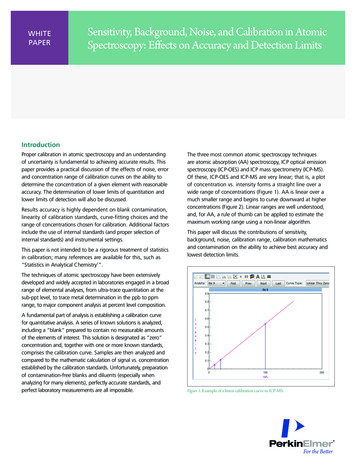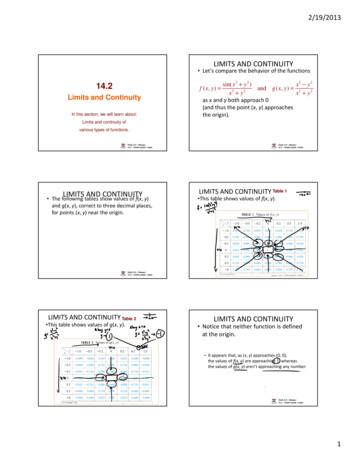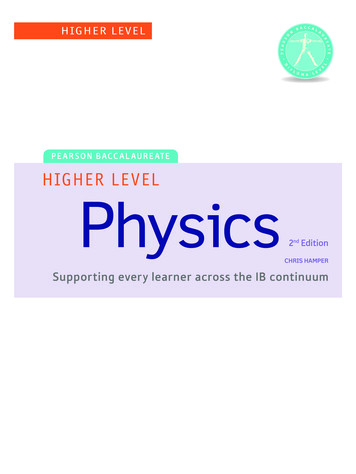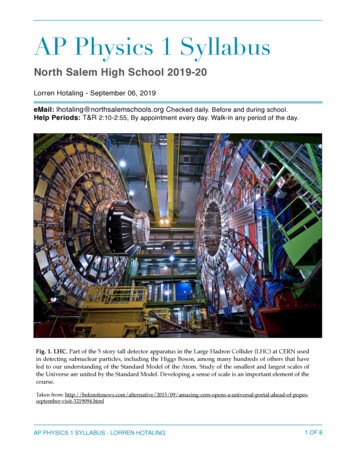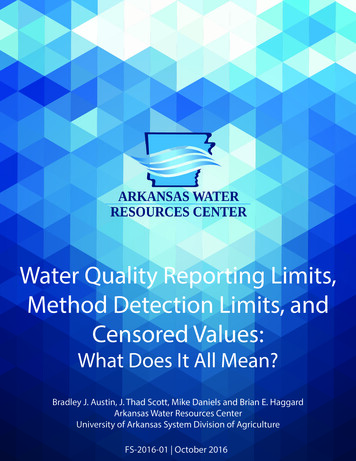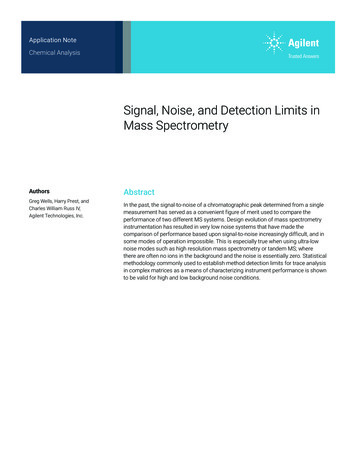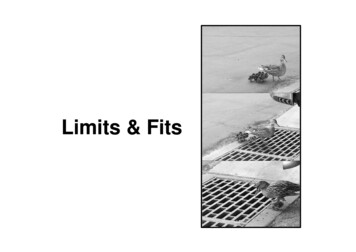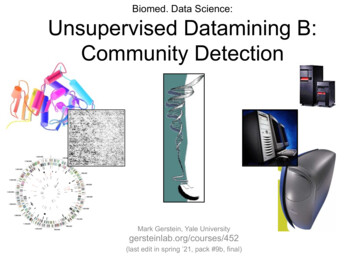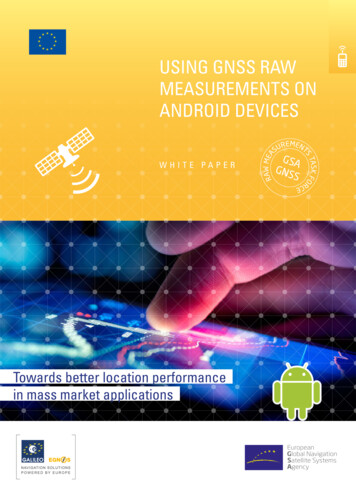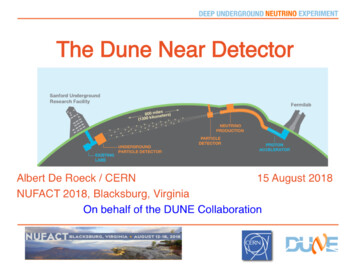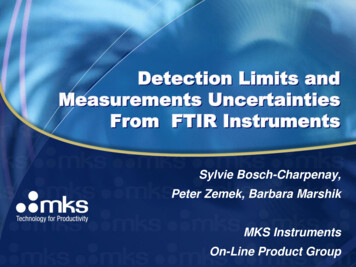
Transcription
Detection Limits andMeasurements UncertaintiesFrom FTIR InstrumentsSylvie Bosch-Charpenay,Peter Zemek, Barbara MarshikMKS InstrumentsOn-Line Product Group
Terminology Detection Limit EPA Method Detection Limit MDL– “Minimum change in concentration of analyte that themethod can detect with 99% confidence limit that achange has occurred” ASTM D6348 Minimum Detection Limit MDC Method 320 Detection limit MAU– “Lowest concentration limit for which its overallfractional uncertainty is less than the analyticaluncertainty (e.g. 5%) chosen”
Factors InfluencingDetection Limit White noise Biases (due to interferences, poor background) NOT (or minimally) influenced by calibration,instrument parameters, etcMKS Confidential3
How do we reportDetection Limits? “Industry-accepted standard” is 3*stdev in N2– Does not account for effect of potential interferent EPA Method 301? MDL– Requires 7 low (non-zero) concentration samples Student’s t table for statistics– Requires capability to create low level concentrations ASTM D6348 MDC– 3 different definitions: which one to use ? Method 320 MAUEPA 40 CFR Part 63 Method 301 - Field Validation of PollutantMeasurements Methods From Various Waste MediaEPA 40 CFR Part 136 - Appendix BHubaux, A., Vos, G., Anal. Chem., 42, 8 (1970) 849-855MKS Confidential4
Terminology (NIST) Repeatability precision– “Closeness of agreement between the results of successivemeasurements of the same measurand (e.g., cylinder) carried out underthe same conditions of measurement” Reproducibility– “Closeness of agreement between the results of measurements of thesame measurand (e.g., cylinder) carried out under different conditions ofmeasurement (e.g., different instrument, different time, different location)” Accuracy– “Closeness of the agreement between the result of a measurement andthe value of the measurand” (qualitative concept) Error– “Result of a measurement minus the value of the measurand” Confidence limit Uncertainty– “A pair of numbers used to estimate a characteristic of a population, suchthat the numbers can be stated with a specified probability that thepopulation characteristic is included between them”MKS Confidential5
Terminology Uncertainty NIST Total Uncertainty– sum of systematic error and random error– Law of Propagation of Uncertainty: square root of thesum of the squares Standard uncertainty u– 1-sigma Expanded uncertainty U u * k– k coverage factor for stated level of confidence (k 1.96 for 95%, k 2.576 for 99%, k 3 for 99.76%) Confidence limit (or confidence interval)– Term used interchangeably with expandeduncertainty
Random vs Systematic ErrorMKS Confidential7
Factors Influencing Uncertainty8
Estimated uncertainty with“good” spectral fit Assuming “good” fit– i.e. no issues with interfering compounds, noisemuch smaller than signal Using released recipesAssuming reading detection limit– i.e., within 20-100 % of range Combined effect of T, P, matrix broadening,resolution, frequency– 3% estimated uncertainty After calibration span– 2% estimated uncertainty Estimates do not hold at low level and poorspectral fit
What if the spectral fit is notvery good ?
How does goodness-of-fitrelate to overall uncertainty ? One of the factors only Loose correlation Reading with a poor spectral fit might still havehigh accuracy (low error)– but it is less likely Reading with a great spectral fit might have alow accuracy (high error) if P, T, span factoretc are not correct However, if we assume all other factors are inspec (P, T, resolution, laser frequency, spanfactor, etc ), goodness-of-fit gives anindication of uncertainty
ASTM D6348, EPA m320 ASTM 6348 provides 3 different “MinimumDetection Limits” calculations– MDC1, MDC2, MDC3 Method 320– MAU detection limit– FRU, FCU, FAU, FMU fractional uncertainties– Uses the largest as the overall uncertainty Calculations across methods are in some casessimilar, but not equivalent
How do ASTM D6348 and EPAm320 compare ? MDC1 and MAU are similar but not equivalent– MDC1 is using RMS and MAU is using the surfacearea in the normalizing denominator MDC2 has no equivalent FRU, FCU, FAU have no equivalent– They are always smaller than MAU and FMU MDC3 and FMU*reading are similar but notequivalent– MDC3 is using RMS and FMU is using the surfacearea in the normalizing denominator
EPA Method 320NameWhat it doesWhat it needsLevelMAU?AnalyticalUncertaintyGoodness-of-fit parameteraccounting for noiseNoise spectrumCan ness-of-fit parameteraccounting for errors inreproducibility of CTS spectraCTS spectra takenbefore and afterreference spectraSmall 1FCUFractionalCalibrationUncertaintyAccounts for errors in Beer’s LawReference SpectraSmall 2FAUFractionalAnalyticalUncertaintyAccounts for errors due to differentpathlengths, T, P between CTSspectra taken at under differentconditionsCTS done withdifferent PL, T, PSmall 3FMUFractionalModelUncertaintyGoodness-of-fit parameteraccounting for errors in the modelto extract multiple concentrationsfrom overlapping compoundsSampleCan belargeOFUOverallFractionalUncertaintyMaximum of all Uncertainties(1) Because Multigas instruments have very similar alignment, and are very stable(2) Because Multigas calibrations have multi points(3) Because Multigas instruments have the same pathlength and are run at the same T, P asthe reference spectra14
ASTM D6348NameWhat it doesWhat it needsLevelMDC1Noise-limitedMinimumDetection LimitGoodness-of-fit parameteraccounting for noiseNoise spectrumCan belargeMDC2AnalyticalAlgorithm ErrorCalculated as 3 * stdev inspectra with no analyte but withinterferentsSpectra withinterferents but noanalyteCan belargeMDC3AnalyticalAlgorithm ErrorGoodness-of-fit parameteraccounting for errors in themodel to extract multipleconcentrations fromoverlapping compoundsSample spectrumCan belarge15
Graphical Goodness-of-fitRepresentationYellow filling:MDC3 orFMU*RSGreen filling:MDC1 or MAU Black calibration spectrum Red sample spectrum Green noise-only spectrum16
Calculations Assume same pathlength, T and P betweenreference and sample This assumption highlights absolutecalculation differences17
ASTM MDC1 and m320 MAUNN ( NEA )2MDC #1 N (Aref i0 )22ii0 ( NEA ) C refMAU N0N (Aref i C ref)iNEAi Noise Equivalent Absorbance at wavenumber i(spectrum in N2)Aref i Absorbance of reference spectrum atwavenumber iCref Concentration of reference spectrumN number of points in analysis region1For constant Aref i A, MDC1 MAU(A) (A) NN200N18
MDC1 vs MAUAbsorbanceMDC1 MAUWavenumberAbsorbanceMDC1 MAUWavenumberMKS Confidential19
ASTM MDC21 P2MDC #2 3 (C C) avepP 0 P spectra containing interferents but no analyteP number of measurements (spectra), minimum 8.Cave average concentration for analyte ( analyticalbias)Cp measured concentration (reading) on spectrum p20
ASTM MDC3 and m320 FMUNMDC #3 ( REAi )0N (Aref i0)N22 C refFMU N2(REA) i0N ( Arefi ) C refRSi REAi Residual Equivalent Absorbance at wavenumber i Aref i Absorbance of reference spectrum at wavenumber i Cref Concentration of reference spectrum N number of points in analysis region RS reading of sample For constant Aref i A, MDC1 FMU*RS21
SEC standard error of estimatedconcentrationNSEC Cref 2N (Aref i)2 ( REA )i0( N 1)N2SEC 1( N 1) ( REA )2i0N (Aref i C ref)200 REAi Residual Equivalent Absorbance atwavenumber i Aref i Absorbance of reference spectrum atwavenumber i Cref Concentration of reference spectrum N number of points in analysis region22
Comparison ASTM MDC3 and SECN ( REA )N2iMDC #3 0N (Aref i0 )2 C refSEC 1( N 1) ( REA )2i0N2(A) ref i C ref0SEC calculation is similar to MDC3, except that itincludes an additional factor of 1/sqrt(N-1), with N number of points in analysis regionThe additional factor is because the error is assumedto be random instead of systematicSEC values are much smaller than MDC3, and areloosely correlated to the precision (standard deviationin N2)23
Where does the /- from MG2000fit in?NNMG 2000 / 2(REA) i0N (Aref ii ) C refFMU N2(REA) i0N ( Arefi ) C refRSiSimilar to FMU*RS except smaller by a factor orsqrt(N)Similar in value to SEC (but not equivalent, againdue to different normalizing denominator)Closer to a precision value than an uncertainty value24
What do I need for DLcalculation and if possibleuncertainty calculation ?MKS Confidential25
MKS Analysis Validation Utilityprovides needed parameters MDC1, MDC2 and MDC3 calculated MAU and FMU calculated FRU, FCU, FAU not calculated– They are smaller than MAU and FMU– FRU small because Multigas instruments have verysimilar alignment and are very stable– FCU small because of multi-points calibrations– FAU small because Multigas instruments have thesame pathlength and are run at the same T, P as thereference spectra SEC and /- ?MKS Confidential26
Parameters in MKS’s AnalysisValidation UtilityMDC1, MAUMDC2MDC3, FMU*ReadingPurposeQuantifygoodness-of-fitfor noiseQuantify detectionlimit from precisionQuantify goodness-offit for sampleRequiredspectraOne noise-onlyspectrumAt least eightinterference-onlyspectraSample SpectrumComments onrequiredspectraEasy to obtain,can be the firstspectrum in N2taken after abackgroundCan be difficult toobtain for eachinstrumentAvailableAssumes allerror issystematicCombination ofmostly random(noise) and somesystematic(interferent) errorAssumes all error issystematicDrawbacks27
ExamplesimilarsimilarTypically lower than MDC3 or FMU*R28
Which MDC to use forDetection Limit? MDC2 likely slightly lower than “real” DL– It does not include a measure of bias under sampleconditions– Best option for DL MDC3 likely significantly higher than “real” DL– It assumes all error is systematic.– MDC3 provides more information on the uncertaintythan detection limit MDC1 not directly related to “real” DL– Uses noise-only data– Assumes all error is systematicMKS Confidential29
Estimated Detection Limit DL MDC2 bias– Provides “rule of thumb” values– Value slightly more conservative than MDC2– No goodness-of-fit parameters used in calculation MDC2– Estimate of mostly random error (due to noise) andsome systematic error (due to interferents) at zero Bias– Average bias for analyte in the interferents-only spectraused for MDC2)– Estimate of systematic error due to interferentsMKS Confidential30
Can any MDC be used forConfidence Limit? MDC2 likely lower than “real” CL– It does not include a measure of bias under sampleconditions MDC3 likely higher than “real” CL– It assumes all the error from the goodness-of-fit yieldsa systematic error in the reading MDC1 not directly related to “real” CL– Uses noise-only dataMKS Confidential31
Can we calculate a “Rule ofThumb” Confidence Limit ? Systematic Error Max (MDC3-MDC1-C, bias)– MDC3-MDC1 is a goodness-of-fit estimate of samplesystematic error without the effect of noise– C is typical value for goodness-of-fit for a “good fit”– Bias is estimate of systematic error due to interferents Random Error MDC2 Best level for uncertainty is 2%– “Good fit”– Readings in 20-100% of rangeMKS Confidential32
“Rule of Thumb” Confidence Limit CL max [max (MDC3-MDC1-C, bias) MDC2, 2%]EstimatedSystematicError fromsamplegoodness-of-fitEstimatedSystematicError fromSamplegoodness-of-fitEstimated Errorfrom samplegoodness-of-fit andinterferentsEstimatedSystematicError frominterferentspectraEstimatedRandom ( someSystematic)ErrorEstimated ErrorWith “good”goodness-of-fit (buterrors in T, P, )33
Estimated CL and DLColor-coded for faster evaluationMKS Confidential34
Recommendations MDC2 is best value to use for detection limit– Choice of interference spectra is critical– Nitrogen spectra would only give DL due to noise A more conservative value for DL is MDC2 bias MDC3 is a rough estimate for uncertainty– Because it assumes that all error is systematic– Does not account for significant reduction of randomerror in spectral analysis– Does not account for possible interferent bias CL is a more reliable estimate for uncertainty– Based on goodness-of-fit, precision, and typicalparameters uncertainties– Truly only an estimate ! Could still be “off”MKS Confidential35
Big Question:which spectra for MDC2should be acceptable ? Best choice– Interferents at (multiple) levels covering levels seen insample– Different interferents for each analyte– Collect a minimum of 8 (consecutive, nonconsecutive?) spectra Interference spectra taken on other instrument ? H2O and CO2 interference spectra taken on otherinstrument ? N2 spectra taken on instrument?MKS Confidential36
Recommended Procedure toGenerate DLs Setup instrument– Allow instrument to equilibrate– Load recipe (calibrations instrument parameters) Run interferent gases (no analyte)– Interferents at levels same as in sample– Collect a minimum of 8 (consecutive?) spectra– Calculate stdev and bias (average concentration ofanalyte, which should be close to 0) Calculate DL MDC2 (3 * stdev) and DL MDC2 bias Determine if DL and DL under those conditionsmeets regulatory requirementsMKS Confidential37
Detection Limits? "Industry-accepted standard" is 3*stdev in N2 -Does not account for effect of potential interferent EPA Method 301? MDL -Requires 7 low (non-zero) concentration samples Student's t table for statistics -Requires capability to create low level concentrations ASTM D6348 MDC
